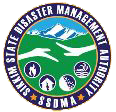Chemical hazard
Chemical agents are poisonous vapours, aerosols, liquids and solids that have toxic effects on people, animals or plants. They can be released by bombs or sprayed from aircraft, boats and vehicles. They can be used as a liquid to create a hazard to people and the environment. Some chemical agents may be odourless and tasteless. They can have an immediate effect (a few seconds to a few minutes) or a delayed effect (2 to 48 hours). While potentially lethal, chemical agents are difficult to deliver in lethal concentrations. Outdoors, the agents often dissipate rapidly. Chemical agents also are difficult to produce.
A chemical attack could come without warning. Signs of a chemical release include people having difficulty breathing; experiencing eye irritation; losing coordination; becoming nauseated; or having a burning sensation in the nose, throat and lungs. Also, the presence of many dead insects or birds may indicate a chemical agent release.
Before a Chemical Threat
What you should do to
prepare for a chemical threat:
- Build an Emergency Supply Kit, which includes items like non-perishable food, water, a battery-powered or hand-crank radio, extra flashlights and batteries. Also include:
- A roll of duct tape and scissors.
- Plastic for doors, windows, and vents for the room in which you will shelter in place. To save critical time during an emergency, pre-measure and cut the plastic sheeting for each opening.
- Make a Family Emergency Plan. Your family may not be together when disaster strikes, so it is important to know how you will contact one another, how you will get back together and what you will do in case of an emergency.
- Plan places where your family will meet, both within and outside of your immediate neighbourhood.
- It may be easier to make a long-distance phone call than to call across town, so an out-of-town contact may be in a better position to communicate among separated family members.
- You may also want to inquire about emergency plans at places where your family spends time: work, daycares and school. If no plans exist, consider volunteering to help create one.
- Knowing your community's warning systems and disaster plans.
- Notify caregivers and babysitters about your plan.
- Make plans for your pets.
- Choose an internal room to shelter, preferably one without windows and on the highest level.
During a Chemical Threat
What you should do in a chemical attack:
- Quickly try to define the impacted area or where the chemical is coming from, if possible.
- Take immediate action to get away.
- If the chemical is inside a building where you are, get out of the building without passing through the contaminated area, if possible.
- If you can't get out of the building or find clean air without passing through the area where you see signs of a chemical attack, it may be better to move as far away as possible and shelter-in-place.
If you are instructed to remain in your home or office
building, you should:
- Close doors and windows and turn off all ventilation, including furnaces, air conditioners, vents, and fans.
- Seek shelter in an internal room and take your disaster supplies kit.
- Seal the room with duct tape and plastic sheeting.
- Listen to your radio for instructions from authorities.
If you are caught in or near a contaminated area, you should:
- Move away immediately in a direction upwind of the source.
- Find shelter as quickly as possible
- If you are outside, quickly decide what is the fastest way to find clean air. Consider if you can get out of the area or if you should go inside the closest building and shelter-in-place.
After a Chemical Threat
Decontamination is needed within minutes of exposure to minimize health consequences. Do not leave the safety of a shelter to go outdoors to help others until authorities announce it is safe to do so.
A person
affected by a chemical agent requires immediate medical attention from a
professional. If medical help is not immediately available, decontaminate
yourself and assist in decontaminating others.
Decontamination guidelines are as follows:
- Use extreme caution when helping others who have been exposed to chemical agents.
- Remove all clothing and other items in contact with the body. Contaminated clothing normally removed over the head should be cut off to avoid contact with the eyes, nose and mouth. Put contaminated clothing and items into a plastic bag and seal it. Decontaminate hands using soap and water. Remove eyeglasses or contact lenses. Put glasses in a pan of household bleach to decontaminate them and then rinse and dry.
- Flush eyes with water.
- Gently wash face and hair with soap and water before thoroughly rinsing with water.
- Decontaminate other body areas likely to have been contaminated. Blot (do not swab or scrape) with a cloth soaked in soapy water and rinse with clear water.
- Change into uncontaminated clothes. Clothing stored in drawers or closets is likely to be uncontaminated.
- Proceed to a medical facility for screening and professional treatment.
(Source: Ready.gov)





